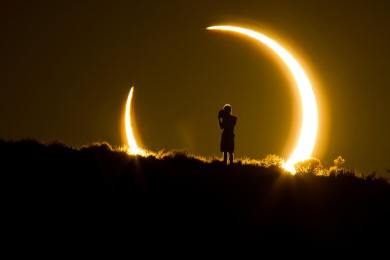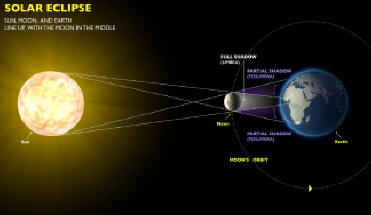Solar Eclipse 2017
Tim Iverson
 (8/2017) When we watch a sunset we are actually looking into the past. It takes about eight minutes for light to travel from the sun to the earth. So, when we view a sunset the sun actually sunk under the horizon eight minutes before! On Monday August 21 the United States
will witness another truly remarkable feature of the sun - a total solar eclipse.
(8/2017) When we watch a sunset we are actually looking into the past. It takes about eight minutes for light to travel from the sun to the earth. So, when we view a sunset the sun actually sunk under the horizon eight minutes before! On Monday August 21 the United States
will witness another truly remarkable feature of the sun - a total solar eclipse.
A total solar eclipse can only occur when the sun, the moon, and the earth line up exactly. If the moon passes between the earth and the sun, the area directly below has a shadow cast down upon it. This is set to occur on Monday August 21 and the shadow will slice across a narrow section of the US from Oregon to South Carolina. Locally, in Maryland, we
can expect to view about 80% of eclipse totality. However, if you can make it to one of the areas in the direct path of the eclipse you can experience a truly remarkable and nearly once in a lifetime event. Total solar eclipses do occur within the US occasionally, the last hitting Hawaii in 1991. However, the last time a total solar eclipse crossed the entire continental
United States was in 1918. The next time an eclipse like this will occur, covering only a portion of the US, will be in 2024 and will cross from Texas upwards toward Maine. By being in the direct path viewers will witness 100% total eclipse darkness. An eclipse event generally takes a few hours, but total darkness will only last a few minutes.
While an eclipse is a remarkable event, they aren’t unique to earth. Other planets in our solar system do have them, but not to the same degree that occurs on Earth. This is due to the relative size and the locations of the players here. Most planets have moons that are too small or too far to create an eclipse event. However, earth has a really large,
really close moon. The sun is about 400 times the size of our moon. Our moon is also about 400 times closer to the Earth than the Sun. What that happy accident means is that both the sun and the moon appear to be the same size. Because of these factors when they align just right the moon appears to blot out the sun. When this happens only the outer atmosphere, the corona, of
the sun is visible and shrouds the area below in darkness.
 There are few things in life that are certain. One of them is that the sun comes up in the morning, goes down at night, and remains bright throughout the day. A total solar eclipse throws this truth upside down, the sun and moon are suddenly doing something they
shouldn’t be. That’s what makes these events so spectacular. Ancient peoples, however, weren’t always so enamored with eclipses. Throughout history different cultures thought demons or something nefarious was consuming or fighting the sun, a veritable god. Vikings thought wolves were eating the sun. The Vietnamese thought a frog had swallowed the sun. Korean mythology tells a
story of fire dogs trying to steal the sun. The dogs never succeed, but manage to take a bite. In many of these traditions terrified people would attempt to scare away the evil spirits by making noise or banging pots and pans.
There are few things in life that are certain. One of them is that the sun comes up in the morning, goes down at night, and remains bright throughout the day. A total solar eclipse throws this truth upside down, the sun and moon are suddenly doing something they
shouldn’t be. That’s what makes these events so spectacular. Ancient peoples, however, weren’t always so enamored with eclipses. Throughout history different cultures thought demons or something nefarious was consuming or fighting the sun, a veritable god. Vikings thought wolves were eating the sun. The Vietnamese thought a frog had swallowed the sun. Korean mythology tells a
story of fire dogs trying to steal the sun. The dogs never succeed, but manage to take a bite. In many of these traditions terrified people would attempt to scare away the evil spirits by making noise or banging pots and pans.
Not all historical traditions or understandings of eclipses were of dread or terror. Some African cultures viewed eclipses as the sun and moon fighting. They would band together outside and encourage them to make peace. The Navajo Indians view eclipses more simply. Their traditions hold it as part of the grand cosmic order and a part of natural
balance. Early Navajo people would regard this time as sacred and spent it with family in song and prayer.
Today we know what an eclipse is and how it occurs. That fact doesn’t make the experience any less magical. It demonstrates just one of the many incredible ways the universe is at work. Given the opportunity people should go and see it, whether it’s locally or by travelling to a place of full totality. Either way, safe viewing is paramount. As children
we learn to never look directly at the sun. By staring directly at the sun permanent damage or blindness can occur. Throughout the region and nation there will be viewing parties. Locally Catoctin Mountain Park and other national parks will host viewing events, and will provide viewing glasses. These glasses are also available for purchase online. With these specialized
glasses you can look at the sun and watch as the sun is eclipsed by the moon. The only, and absolutely only, time you can look directly at the sun without glasses is if you are in the path of 100% totality and the sun is fully eclipsed. Outside of that very brief and narrow circumstance you should not, under any circumstance, look directly at the sun.
The natural world has always been full of wonder. Different animal adaptations are the difference between eating or being eaten. The astronomical world is no different, but the natural world will also take notice of this spectacle. While it won’t be as dark as the dead of night, birds usually come to roost and stop singing. Stars should be visible
during the totality. Temperatures typically drop, by 10 to 15 degrees fahrenheit and breezes come to a stop. Leaves will begin to cast a crescent shaped shadow before and after totality.
Throughout the course of human history the sky above has been integral in both the mythological and scientific realms. A total solar eclipse is just one of the many remarkable features of our home and our place in the cosmos. While a cloudy day could put a damper on the whole event, anyone with the ability to get outside should try to view it. Partial
totality, like what we will experience in the DC region is of course better than nothing. However, if you can make it to a location of full 100% eclipse totality the experience will be worth the effort.